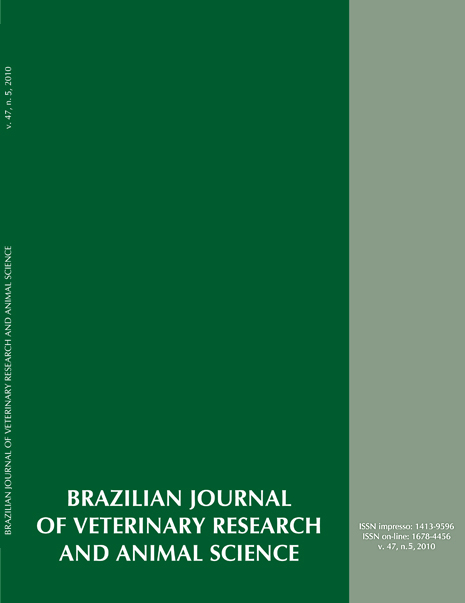Comparative study of clinical cardiorespiratory parameters and recovery times in bitches submitted to ovariohysterectomy and anesthetized with halothane, isoflurane or sevoflurane
DOI:
https://doi.org/10.11606/issn.1678-4456.bjvras.2010.26822Keywords:
Anesthesia, Halothane, Isoflurane, Sevoflurane, DogsAbstract
The cardiopulmonary effects and recovery times of halothane, isoflurane and sevoflurane were compared in bitches submitted to ovariohysterectomy. Twenty-four mongrel dogs were assigned in three groups of eight animals, with medium weight 15.03 kg and 3.93 years of age, designed groups GAH, GAI and GAS. All dogs received acepromazine (0.1 mg/kg, i.m.) as premedication and after 15 minutes, anesthesia was induced with propofol (5.0 mg/kg, i.v.) and maintenance anesthetics were halothane (GAH), isoflurane (GAI) and sevoflurane (GAS). No statistic difference was observed in cardiovascular parameters, but the SAP, DAP and MAP decreased slighty in moment M1 and this effect was associated with propofol. The rectal temperature decreased in function of the time of anesthesia, without difference among groups, but the AI and AS groups presented the lowest values of this parameter. Respiratory rate decreased in all groups, with an increase in the PaCO2 and a decrease in the pH, without statistic differences. The extubation times were similar in the three groups. Time to standing was shorter in the AS group when compared with the GAH and GAI groups. On the basis of the results, for this animal category and surgical procedure halothane, isoflurane and sevoflurane were similar in cardiovascular parameters. All agents caused respiratory depression and the recovery times were shorter in sevofluorano group.Downloads
Download data is not yet available.
Downloads
Published
2010-10-01
Issue
Section
UNDEFINIED
License
The journal content is authorized under the Creative Commons BY-NC-SA license (summary of the license: https://
How to Cite
1.
Mattos Junior E de, Ito KC, Conti-Patara A, Carvalho HS de, Caldeira J de A, Reinoldes A, et al. Comparative study of clinical cardiorespiratory parameters and recovery times in bitches submitted to ovariohysterectomy and anesthetized with halothane, isoflurane or sevoflurane. Braz. J. Vet. Res. Anim. Sci. [Internet]. 2010 Oct. 1 [cited 2025 Dec. 30];47(5):403-12. Available from: https://revistas.usp.br/bjvras/article/view/26822





